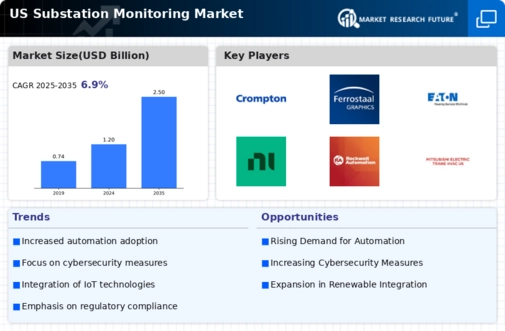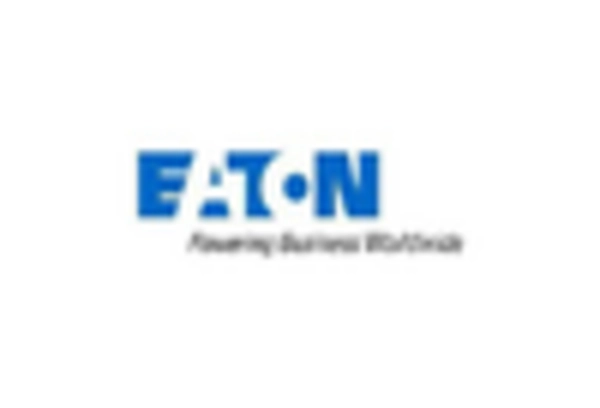The substation monitoring market is characterized by a dynamic competitive landscape, driven by the increasing demand for reliable and efficient energy management solutions. Key players are focusing on innovation, digital transformation, and strategic partnerships to enhance their market positioning. Companies such as Siemens (DE), Schneider Electric (FR), and General Electric (US) are at the forefront, leveraging advanced technologies to optimize operations and improve service delivery. Their collective strategies not only foster competition but also contribute to the overall growth of the market, as they seek to address the evolving needs of utility companies and industrial clients.
In terms of business tactics, companies are increasingly localizing manufacturing and optimizing supply chains to enhance operational efficiency. The market structure appears moderately fragmented, with several players vying for market share. However, the influence of major companies like ABB (CH) and Eaton (IE) is substantial, as they continue to innovate and expand their offerings. This competitive environment encourages collaboration and knowledge sharing, which may lead to enhanced product development and service delivery.
In October 2025, Siemens (DE) announced a strategic partnership with a leading software firm to integrate AI-driven analytics into its substation monitoring solutions. This move is expected to enhance predictive maintenance capabilities, thereby reducing downtime and operational costs for utility providers. The integration of AI signifies a shift towards more intelligent and responsive energy management systems, aligning with the broader trend of digitalization in the industry.
In September 2025, Schneider Electric (FR) launched a new suite of cloud-based monitoring tools designed to improve real-time data analysis for substations. This initiative reflects the company's commitment to sustainability and efficiency, as it enables utilities to optimize energy consumption and reduce carbon footprints. The emphasis on cloud solutions indicates a growing trend towards remote monitoring and management, which could reshape operational practices in the sector.
In August 2025, General Electric (US) expanded its substation monitoring portfolio by acquiring a startup specializing in IoT technologies. This acquisition is likely to enhance GE's capabilities in providing integrated solutions that leverage IoT for improved data collection and analysis. The strategic importance of this move lies in its potential to position GE as a leader in the integration of IoT within substation operations, thereby enhancing its competitive edge.
As of November 2025, current trends in the substation monitoring market include a strong focus on digitalization, sustainability, and the integration of AI technologies. Strategic alliances are increasingly shaping the competitive landscape, as companies recognize the value of collaboration in driving innovation. Looking ahead, competitive differentiation is expected to evolve, with a shift from price-based competition towards a focus on technological advancements, innovation, and supply chain reliability. This transition may redefine how companies position themselves in the market, emphasizing the importance of delivering value through cutting-edge solutions.

















Leave a Comment